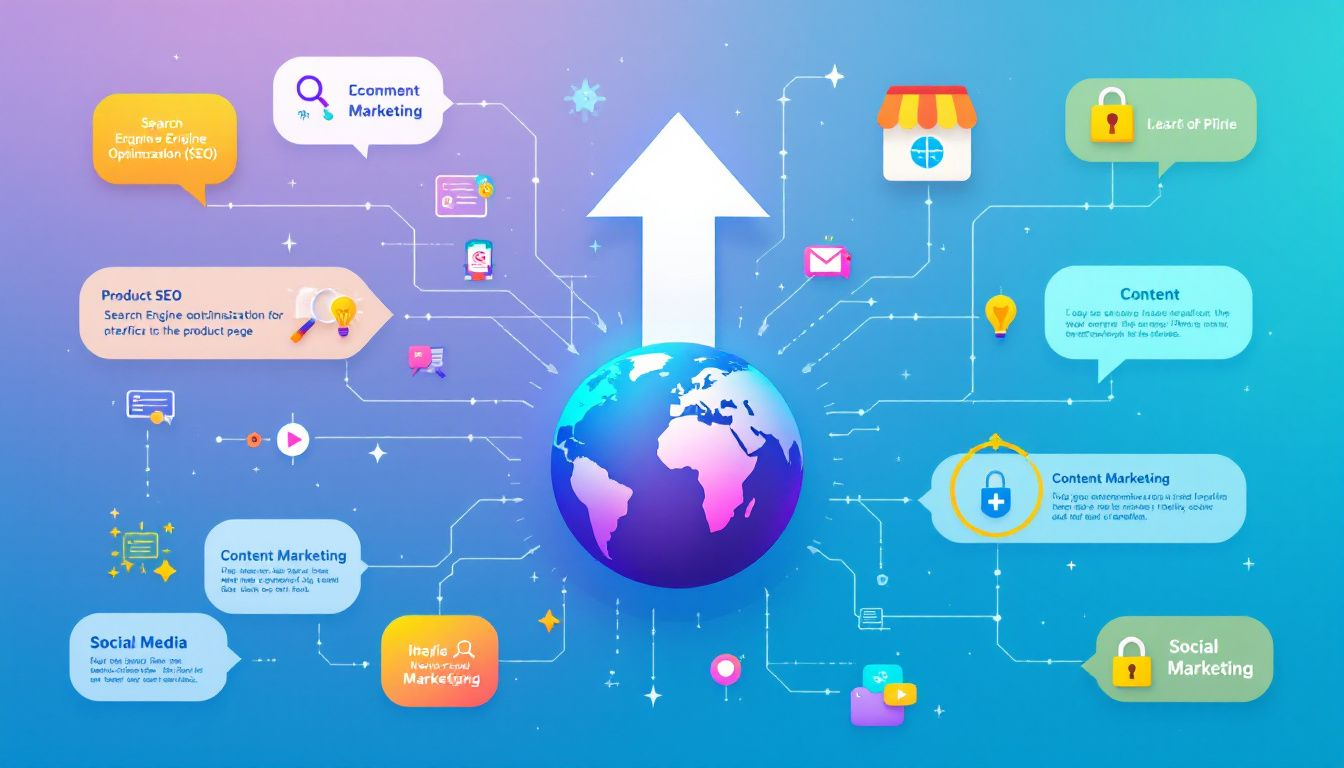If you’re looking to boost your eCommerce site’s visibility and organic traffic, understanding and implementing effective eCommerce link building strategies is crucial. This article will guide you through the most effective techniques to earn high-quality backlinks that can improve your search engine rankings and drive more potential customers to your site.
Key Takeaways
- Building high-quality backlinks is crucial for eCommerce SEO, as they enhance visibility and drive organic traffic.
- Effective strategies include manual outreach to bloggers, guest posting, leveraging unlinked brand mentions, and creating valuable blog content.
- Regularly monitoring link-building efforts using analytics tools allows for data-driven adjustments, optimizing eCommerce site performance.
The Power of eCommerce Backlinks

Mastering the art of link building is essential for any eCommerce site. When your site garners links from other websites, it signals to search engines that your content has value and credibility. This recognition can lead to improved rankings on search engine results pages (SERPs), which is critical in a highly competitive online space.
Having quality backlinks increases your eCommerce business’s visibility on search platforms, funneling more organic traffic to your website—a vital component for sustainability and growth. Attracting potential customers organically often leads to higher conversion rates as these users discover what you offer through trusted sources. Securing high-quality backlinks from respected sites not only builds trust, but also gives you an edge over competitors by boosting both credibility and SEO positions.
The benefit of a backlink correlates with the authority of its source. Those coming from reputable sites hold greater influence, thereby markedly improving SEO standings—a factor particularly crucial in the cutthroat realm of eCommerce where gaining every advantage matters greatly. High-caliber links rank as one of the top three factors influencing ecommerce-related SERP placements, highlighting their paramount importance.
An effective link-building strategy does more than just elevate brand presence—it draws increased customer engagement that could translate into superior sales figures due to elevated confidence levels spurred by natural endorsements rather than artificial constructs. As such, executing proficient link-building practices remains indispensable for any ecommerce enterprise seeking prosperity now or towards 2025.
Effective Link Building Strategies for eCommerce Sites

Effective link building strategies are essential for eCommerce businesses to navigate the competitive digital landscape. Strategies like manual outreach to bloggers and leveraging unlinked brand mentions can significantly enhance your site’s SEO and drive organic traffic.
Let’s delve into some of the most effective link building techniques that can help you build a strong backlink profile.
Manual Outreach to Bloggers
Efforts in link building within the eCommerce sector rely heavily on hands-on outreach to bloggers. Establishing connections with these online influencers can broaden your brand’s reach and engage new audiences, bolstering your link-building strategy significantly. To secure a successful partnership, it’s essential to communicate how partnering with you would enrich their content—increasing the odds that they’ll be receptive.
Reaching out directly to niche-specific bloggers or websites for product evaluations or collaborative content is key for improving visibility and securing high-quality backlinks. Persuade them by underscoring what advantages their audience stands to gain from your products or services.
For enduring success in generating quality backlinks, investing time into building sincere relationships through manual outreach is fundamental. Such rapport sets up a foundation of trust which paves the way for future collaborations resulting in premium backlinks. By consistently adding value and nurturing these communications, you create an alliance of dedicated bloggers who are more inclined to include links directing traffic towards your website, enhancing both organic traffic flow and SEO standings.
Guest Posting on Relevant Blogs
Building links through guest posting on pertinent blogs is a powerful tactic for enhancing an eCommerce link building strategy. It not only establishes your authority but also introduces your brand to potential customers actively interested in what you have to offer. Keep in mind, though, that this approach often requires significant time investment and sometimes entails costs since many website owners seek payment for hosting external content.
Despite these obstacles, the advantages of guest posting are noteworthy. Products that stand out have the capacity to garner media coverage and backlink opportunities. To be effective at building links via blog posts, creating compelling articles of high quality is essential — ones that resonate with the target audience’s interests will foster both brand recognition and trust.
In engaging with guest posting endeavors, it’s crucial to aim for esteemed sites and relevant resource pages within your specific market area. By doing so, you’ll ensure that any acquired backlinks, especially niche relevant backlinks, are meaningful and reinforce your search engine optimization (SEO) objectives effectively. Choosing strategically which blogs you write for—and producing persuasive material—will amplify the results from your efforts in guest blogging.
Leveraging Unlinked Brand Mentions
Unlinked brand mentions are a goldmine for eCommerce link building strategies. These instances occur when your brand is mentioned but not linked to your website. People sometimes forget to link to your brand when mentioning it in a blog post; identifying these opportunities can lead to easy, high-quality backlinks.
Tools like Ahrefs Content Explorer can help you find unlinked brand mentions. Typing your brand or product name in quotation marks helps locate mentions without a link.
Reaching out to the authors of these mentions and requesting a link back to your site can convert them into valuable backlinks, enhancing your SEO.
Creating High-Quality Blog Content
Attracting backlinks and boosting SEO is crucial, which can be accomplished through top-notch blog content. Crafting well-researched guides that address the issues your audience faces will not only position your blog as a prime resource but also organically draw in links to enhance eCommerce backlink building.
Making your existing content more comprehensive by expanding on topics, incorporating multimedia elements, or including fresh findings will render it more appealing for acquiring backlinks. If you produce material that outshines what’s available on other sites, those platforms are likely to link to yours as an authoritative reference.
Actively reaching out once high-quality content is published boosts the chances of securing backlinks from external websites. By creating captivating blog posts and engaging in strategic outreach efforts, you’ll likely gather additional backlinks that propel both organic traffic and overall site SEO forward.
Utilizing Niche Edits
Incorporating niche edits, also known as “link insertions,” into your link building strategy can lead to swift and efficient acquisition of backlinks by adding links to pre-existing content on external websites. Conducting a content gap audit is advantageous for pinpointing pertinent articles that could be enhanced with your links. This deliberate method guarantees the relevance and value addition of the obtained links.
When engaging in conversations with publishers for niche edits, steer clear of purchasing backlinks from low-quality or spammy websites in order to preserve the integrity of your link profile. While there’s typically an expense involved in procuring niche edits, they are considered a valuable investment due to their positive impact on keyword rankings and boosted relevance. By aiming for high-caliber sites relevant to your field when seeking out niche edits, you stand to substantially bolster your overall link building efforts.
Advanced Techniques for Building eCommerce Links

Once you have a firm grasp on the fundamentals, delve into sophisticated strategies to enhance your link building for an eCommerce site. Employing tactics such as the Skyscraper technique, niche edits, and generating unique research can amplify your link-building endeavors and make sure that your eCommerce platform distinguishes itself in a bustling marketplace.
Developing Resource Pages
Constructing resource pages is an efficient strategy for garnering backlinks. These pages are pivotal as they become a central point for referring to insightful content, and their efficiency in accruing backlinks stems from this attribute. By crafting content that caters specifically to certain demands, owners of resource pages may be inclined to link back to your material.
Utilizing tools like Hunter.io can simplify the process by locating contact information for proprietors of these resource pages, thereby facilitating more effective outreach efforts. Personalized emails with engaging subject lines and tailored recommendations on content significantly enhance the likelihood that recipients will engage with your email leading them towards taking action.
Engaging in collaborative marketing ventures also offers fresh opportunities for creating additional material where backlinks flow naturally within the context of shared promotional efforts.
Conducting Original Research
Conducting original research is an effective strategy to gain high-quality backlinks, as it offers unique data that can be cited by others, thus ensuring valuable backlinks for your eCommerce website. Pages filled with statistics are especially attractive to bloggers and journalists who need trustworthy sources, resulting in important backlinks.
Before you create a statistics page on your site, verify if there’s active interest and citation behavior around such data. By doing this preliminary check, you make certain that the work you put into developing the page yields targeted results.
Creating authentic content not only enhances your search engine rankings, but also establishes your credibility. This turns your eCommerce site into a reputable hub of information.
Partnering with Influencers
Forging alliances with influencers can significantly elevate your ecommerce link building strategy. These collaborations not only expand the reach of your brand, but also frequently lead to the acquisition of quality backlinks. Influencer endorsements, regarded as genuine and trustworthy, are priceless in amassing backlinks.
The moment an influencer disseminates information about your content or items, there is a substantial uptick in both brand exposure and the influx of organic traffic along with natural links. For optimal enhancement of your link building endeavors, it’s crucial to select influencers whose followers mirror your own desired customer base.
Leveraging Partnerships for Link Building
Forming strategic alliances with affiliates and business counterparts can greatly bolster your link building endeavors. Such collaborations facilitate the natural integration of links, attract high-quality traffic, and deliver reciprocal advantages that fortify your backlink portfolio.
Building Affiliate Relationships
Link building relies heavily on the pivotal role of affiliate partnerships. These collaborations not only elevate sales but also secure links from sites of high quality. Such alliances can amplify your visibility, fostering a growth in organic backlinks which, in turn, strengthen your website’s search engine optimization.
To ensure these affiliate relationships are productive, selecting suitable partners and showcasing the profitability of your program is crucial. Nurturing robust connections with affiliates paves the way for a web of quality backlinks that bolster both the authority and online prominence of your site.
Business Collaborations
Entering into partnerships with other businesses can serve as a tactical method for strengthening your link building campaigns. Engaging in joint promotional activities with different companies can pave the way for opportunities to exchange backlinks, which boosts product exposure and cultivates trust among consumers.
Forge alliances, particularly with brands offering complementary goods, as these collaborations are often most fruitful. Such strategic relationships have the potential to enrich your profile of backlinks considerably, propelling traffic that is specifically interested in your offerings while bolstering your position within search engine results.
Optimizing Product Pages for Link Building

Optimizing product pages is crucial for attracting backlinks and improving your SEO. An integrated blog can effectively generate backlinks, driving organic traffic and enhancing keyword rankings.
Let’s explore how you can optimize product pages to maximize their link-building potential.
Answering FAQs
Answering FAQs on product pages can earn backlinks and help rank for bottom-of-funnel keywords, potentially leading to sales. FAQ pages provide solutions and rank for long-tail keywords, making them valuable for eCommerce link building.
An example of using FAQs is addressing fears of being locked out for smart locks, which mitigates purchase anxiety. By optimizing FAQ pages, you can attract backlinks and rank for multiple keywords, enhancing your site’s SEO and driving organic traffic.
Highlighting Unique Selling Points
By accentuating the distinctive selling propositions on your product pages, you not only set your products apart, but also draw in potential customers and other websites. This can result in acquiring beneficial backlinks that enhance your SEO efforts by highlighting what makes your offerings unique.
Monitoring and Analyzing Your Link Building Efforts
It is crucial to consistently monitor and analyze the effectiveness of your link building strategies in order to determine their influence on your SEO outcomes. By frequently assessing these efforts, you can pinpoint the most effective tactics and make necessary adjustments promptly to enhance your link building endeavors.
Using Analytics Tools
Tools such as Ahrefs, Moz, and Semrush offer valuable data on the caliber of backlinks through metrics like domain authority and the variety in anchor text usage. These instruments are crucial for gauging both the volume and quality of your eCommerce site’s backlinks, thereby allowing you to measure your performance with precision.
Google Alerts is an excellent resource for detecting unlinked brand mentions, which presents a chance to transform those mentions into valuable backlinks. Employing these analytics tools will enable you to keep tabs on fluctuations in keyword positions and organic traffic flow, confirming that your link building strategies are proceeding correctly.
Adjusting Strategies Based on Data
Leveraging analytics enhances your link building strategy by utilizing performance metrics and trend analysis. Tracking the increase in backlinks and changes in keyword positions enables you to identify which tactics yield the best results, focusing your efforts accordingly.
By employing a dynamic lost link building strategy that adjusts to fluctuating data and emerging trends, you optimize your SEO campaigns. Through consistent evaluation of performance and informed tweaks based on empirical evidence, there’s potential for continuous advancement in your link building endeavors.
Case Study: Successful eCommerce Link Building Campaigns
Examining actual instances where link building campaigns have triumphed offers crucial understanding of the strategies that yield positive results. We will delve into a pair of case studies showcasing the strength of proficiently conducted link building efforts within the realm of eCommerce.
Example 1: Perfect Keto’s Strategy
Perfect Keto devised an effective link building strategy, greatly improving their digital presence. By acquiring more than 350 quality backlinks, they saw a considerable surge in organic traffic, jumping from monthly views of between 2,000 and 4,000 to surpassing 30,000 views.
The remarkable growth in both backlinks and website visitors underscores the success of Perfect Keto’s approach. Concentrating on the relevance and high-quality nature of these links led to outstanding outcomes that markedly enhanced their SEO standing.
Example 2: Made In Cookware’s Growth
Embarking on a fruitful SEO voyage, Made In Cookware honed in on potent link building strategies which resulted in considerable expansion. Presently, they hold rankings for 31,000 keywords and receive around 33,000 organic views per month — evidence of their robust performance in search engine optimization.
Made in the USA. In Cookware’s endeavors in link building have substantially boosted their online visibility within the cookware industry marketplace. Through focused efforts to secure relevant links and place content strategically, they’ve realized remarkable achievements with keyword positions and an uptick in web traffic growth.
Common Mistakes to Avoid in eCommerce Link Building

Ensuring that you sidestep prevalent errors during the process of eCommerce link building is essential for sustaining a robust backlink profile and enhancing your search engine optimization initiatives. Neglecting to keep an eye on backlink metrics might result in overlooking issues such as disappearing or detrimental links. The failure to leverage the disavow tool leaves your website exposed to negative impacts from low-quality backlinks.
Acquiring backlinks from sources with a deleterious link portfolio can be damaging to how well your site fares in rankings, while securing links from websites with minimal authority could undermine your credibility. Constructing connections from sites without relevance or excessively employing exact match anchor text could tarnish the reputation of your site, and suffering a broken link may negatively influence where you stand in search engine results. It’s essential to avoid creating unnatural links, as this is one of the common mistakes to avoid in eCommerce link building.
By varying your approaches and steering clear of these common setbacks, you are able to fortify an effective strategy for building links which promises greater resilience and efficacy.
Summary
In summary, mastering eCommerce link building strategies is essential for any online business looking to thrive in 2025. From manual outreach to bloggers and guest posting on relevant blogs to leveraging unlinked brand mentions and creating high-quality blog content, each strategy plays a vital role in building a strong backlink profile.
By implementing advanced techniques like developing resource pages, conducting original research, and partnering with influencers, you can take your link building efforts to the next level. Additionally, exploring SaaS link building strategies can further enhance your efforts, especially if you’re in the SaaS industry, by targeting niche opportunities and scaling your backlink acquisition. Regularly monitoring and analyzing your efforts ensures you stay on track and make data-driven adjustments.
Frequently Asked Questions
What are eCommerce backlinks?
eCommerce backlinks are external links from other websites that direct traffic to eCommerce sites, enhancing their authority and visibility online. These links are crucial for improving search engine rankings and attracting potential customers.
What is the expected benefit of eCommerce link building?
The expected benefit of eCommerce link building is the enhancement of a site’s search visibility and traffic, which can ultimately lead to higher conversions and sales.
How can I find unlinked brand mentions?
Utilize specialized tools for brand monitoring or configure Google Alerts to track mentions of your brand that are not accompanied by hyperlinks. By doing this, you will be able to identify unlinked mentions of your brand and interact with users who are talking about it.
Why is conducting original research beneficial for eCommerce link building?
Undertaking original research proves advantageous for eCommerce link building, as it yields exclusive data that magnetizes quality backlinks from entities in search of dependable information. Such a strategy not only elevates the credibility of your website, but also cultivates confidence within your sector.
What should eCommerce brands consider when choosing link building strategies?
eCommerce brands should consider their expertise, budget, and time availability when choosing link building strategies.
A tailored approach that combines various methods will yield the best results.




